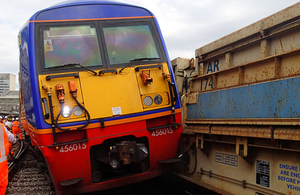Report 19/2018: Collision at London Waterloo
RAIB has today released its report into the collision at Waterloo station, London, on 15 August 2017.

Passenger train and wagons after the collision at London Waterloo
Summary
At around 05:42 hrs on Tuesday 15 August 2017, a passenger train was leaving London Waterloo station when it collided with a stationary engineering train at a speed of 13 mph (21 km/h). No injuries were reported but both trains were damaged and there was serious disruption to train services until the middle of the following day.
The passenger train was diverted away from its intended route by a set of points which were positioned incorrectly as a result of uncontrolled wiring added to the signalling system. This wiring was added to overcome a problem that was encountered while testing signalling system modifications which were being made as part of a project to increase station capacity. The problem arose because the test equipment design process had not allowed for alterations being made to the signalling system after the test equipment was designed.
The actions of a functional tester were inconsistent with the competence expected of testers. As a consequence, the uncontrolled wiring was added without the safeguards required by Network Rail signalling works testing standards, and remained in place when the line was returned to service.
A project decision to secure the points in the correct position had not been implemented.
An underlying factor was that competence management processes operated by Network Rail and some of its contractors had not addressed the full requirements of the roles undertaken by the staff responsible for the design, testing and commissioning of the signalling works.
The RAIB has observed that there are certain similarities between the factors that caused the Waterloo accident and those which led to the serious accident at Clapham Junction in 1988. The RAIB has therefore expressed the concern that some of the lessons identified by the public inquiry, chaired by Anthony Hidden QC following Clapham, may be fading from the railway industry’s collective memory.
Recommendations
As a result of the investigation, the RAIB has made three recommendations. The first, addressed to Network Rail, seeks improvements in the depth of knowledge and the attitudes needed for signal designers, installers and testers to deliver work safely. Recommendations addressed to OSL Rail Ltd and Mott MacDonald Ltd seek development and monitoring of non-technical skills among the staff working for them.
The RAIB has also identified four learning points. One highlights the positive aspects of a plan intended to mitigate an unusually high risk of points being moved unintentionally. The others reinforce the need to follow established procedures, prompt staff to clearly allocate duties associated with unusual activities and remind staff that up-to-date signalling documentation must be available and easily identified in relay rooms and similar locations.
Simon French, Chief Inspector of Rail Accidents said:
The disastrous collision at Clapham Junction on 12 December 1988, in which 35 people died and 484 were injured, was a turning point in the history of Britain’s railways. The immediate cause of the accident was poor working practice by a signalling technician, and the subsequent public inquiry into the accident highlighted serious deficiencies in the management of safety, particularly around the design, modification, testing and commissioning of signalling systems. Putting in place the recommendations of the inquiry fundamentally changed several aspects of how the railway is run, and for signal engineers one of the most important was the approach to routine tasks, such as testing alterations to signalling installations. It was therefore concerning for RAIB to discover, during our investigation of the collision at Waterloo last year, that some of these important changes were not reflected in the way that signalling modifications were being undertaken.
Some of the people involved in the signalling work connected with upgrading Waterloo station and its approach tracks did not keep proper records of temporary works, or ensure that additional temporary wiring was shown on the design documents. Leaving that temporary wiring in place when it should have been removed led to a passenger train being diverted onto a blocked line and colliding with wagons. Compliance with the existing standards, developed since Clapham, would have provided the controls needed to stop temporary wiring being installed and used in the uncontrolled manner which resulted in this accident.
These symptoms of a deep-seated problem should give us all pause for thought. How can organisations ensure that lessons from events that happened outside the personal experience of present-day railway people are taught and retained? Compliance with a standard comes more naturally to people when they understand the purpose of the requirement, and the consequences that may arise from disregarding it.
We are recommending that Network Rail takes action to develop and reinforce a positive safety culture within the signal engineering profession as a whole, by putting in place processes to educate present and future staff about how and why the standards have been developed, and why these things matter. It’s also important to give people the skills to recognise and deal with non-compliant behaviour, whether that behaviour is by themselves or their colleagues. I believe that this accident at Waterloo starkly demonstrates why the lessons of Clapham should never be forgotten.
Notes to editors
- The sole purpose of RAIB investigations is to prevent future accidents and incidents and improve railway safety. RAIB does not establish blame, liability or carry out prosecutions.
- RAIB operates, as far as possible, in an open and transparent manner. While our investigations are completely independent of the railway industry, we do maintain close liaison with railway companies and if we discover matters that may affect the safety of the railway, we make sure that information about them is circulated to the right people as soon as possible, and certainly long before publication of our final report.
- For media enquiries, please call 01932 440015.